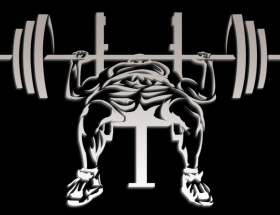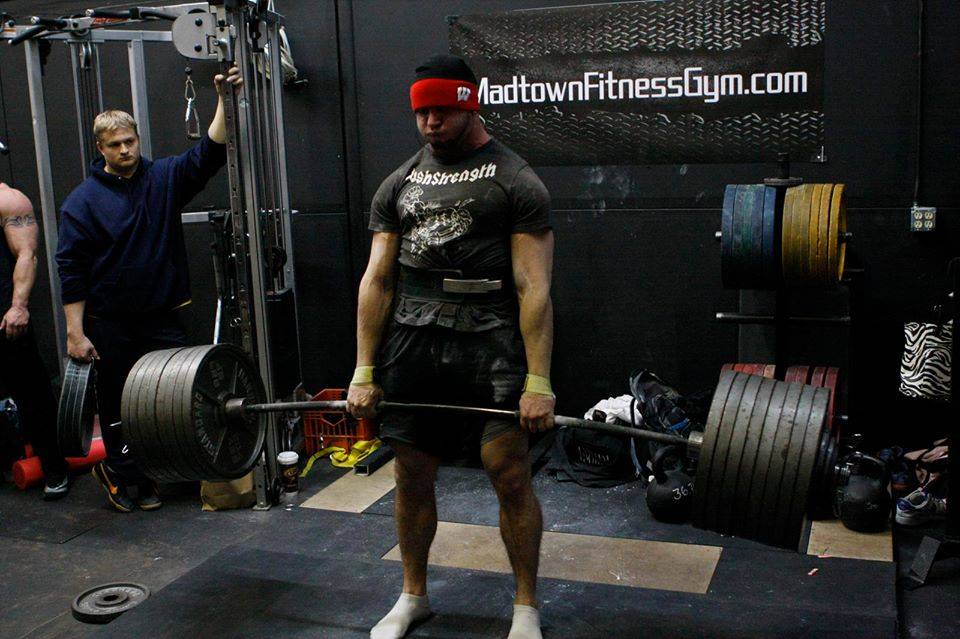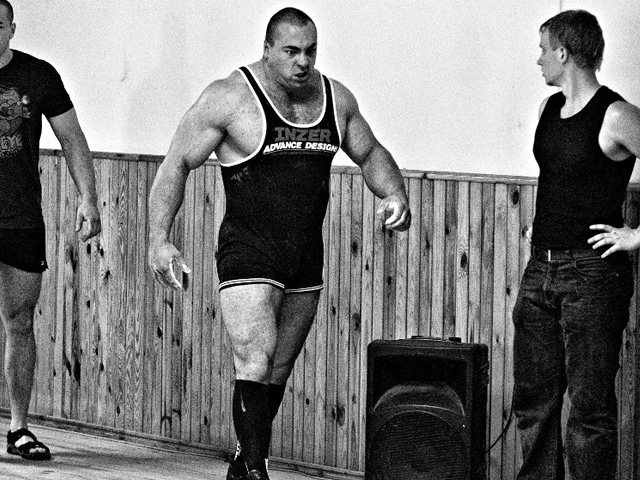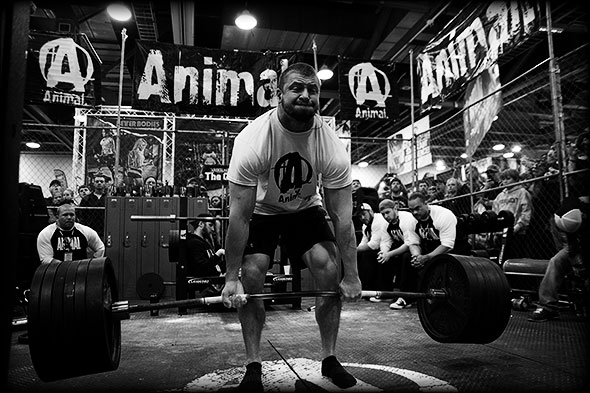Here’s what you need to know…
- You don’t have to work up to a one rep max to get the full benefit of the maximum effort method.
- Gains made within the 90 to 100% range will lead to an increase in your 1RM, even if you aren’t working up to a true max every workout.
- Training is not testing. Displaying strength is not always the same as building it.
- Using a 2-3RM allows for better recovery, safer training, more frequent sessions, and better muscle gains than 1RMs.
- Powerlifters, especially geared ones, of course have to practice more with 1RMs, but even they would build more strength using 2-3RMs in training.
The Truth About The 1RM

My favorite number of reps to do per set is one.
I’m a strong advocate of the maximum effort method, and ramping up to a 1RM has always been a significant part of programs. So this may surprise you:
Ramping to a 1RM is not the best way to do maximum effort work.
It works really well for 4 to 6 weeks, but after that you tend to show signs of stagnation and even regression. For that reason I’ve changed the way I do maximum effort for myself and my athletes.
For most of us, there’s no need to do 1RMs. A 2RM or 3RM actually works better for building strength. Here’s why.
Defining Maximum Effort Work

Most people associate the maximum effort method with two things:
- Working up to the maximum amount you can lift for one repetition (1RM) on a basic movement
- Westside Barbell
Well, most people are wrong!
It’s true that the Westside Barbell system uses a variant of the maximum effort method every week, along with the dynamic effort method and the repetition method. But most people really only think about the max effort method when they think of Westside.
But the maximum effort method had been around for much longer than that. Before Westside, powerlifters would „max out“ only at the end of their training cycle.
People also believe, wrongfully, that the max effort method is all about working up to a maximum lift for one rep. Not true.
Zatsiorsky explains that the maximum effort method consists of lifting loads that are in the 90-100% range. You don’t have to work up to a maximum for a single rep to do max effort.
In Russian weightlifting literature, an important measure is the number of lifts at or above 90% of maximum, not the number of maximal lifts.
How Maximum Effort Works

The nervous system decides how the muscles will produce force to overcome a resistance. It can increase force production via four mechanisms:
1. Recruitment of muscle fibers: The more muscle fibers are recruited when doing an action the more force you can produce. And the more fast-twitch those recruited fibers are, the higher the force output.
So the first way to produce a stronger muscle contraction is to become efficient at recruiting more muscle fibers, and becoming especially efficient at turning on the most powerful fast-twitch fibers.
2. Rate coding/firing rate: Your body has a limited capacity to recruit muscle fibers. The way to increase force production once it becomes hard to recruit more muscle fibers is to increase the firing rate of the recruited fibers.
Every time a muscle fiber „fires“ it produces force. So the faster it can fire, or the more twitches it can do per unit of time, the more force the muscle will produce.
Past the beginner stage, improving rate coding/firing rate is the main way the body adapts to producing more force.
3. Intramuscular coordination/muscle fiber synchronization: This means having the recruited muscle fibers fire in the most advantageous pattern to execute the movement.
It doesn’t always mean firing everything at once. Sometimes the best recruitment pattern is asynchronous. In fact, in the slow-speed strength movements (deadlift, squat, bench press, military press) it almost always is.
4. Intermuscular coordination: This refers to how the body uses the various muscles involved in the movement. For example, the antagonists must relax at the right time to allow the agonists/prime movers to do their job, but not so early that you lose stabilization.
If the antagonists don’t relax enough you’ll be fighting your own body, on top of fighting the weight. If they relax too much you might lack stability, get injured, or not have a strong foundation from which to push off.
The last two elements are done through frequent practice of the movement. The more often you practice a lift under a significant load, the better your intra and intermuscular coordination will be.
Related: Russian Strength-Skill
Rate coding/firing rate and muscle fiber recruitment are the elements improved the most via the max effort method. And in intermediate and advanced athletes, gains come almost exclusively through rate coding.
The Power of Rate Coding

Rate coding is the same for weights in the 90-100% range. It isn’t superior with weights of 97-100%.
As long as you’re training in the 90-100% range you’ll get the proper neurological adaptations. So it becomes a matter of what load and set/rep scheme will allow you to do the most work without any drawbacks while staying in that 90-100% zone.
To develop strength, weights of 90 to 100% have a similar effect. In fact, weights of 90-95% of your maximum done for sets of 2 or 3 reps are likely superior to doing all-out max sets of 1 rep.
Maxing out on a 1RM is useful for powerlifters because they need to learn to perform at an optimal level for a single shot. You’ll likely notice that during a set of 2-3 reps, the second rep is often better than the first one. So being able to perform on the first rep is a skill that powerlifters must develop.
But for most of us, working up to a 2 or 3RM when doing a max effort will be more effective. In fact, even for powerlifters, working up to a 2RM during their max effort day would build more strength than working up to a 1RM. Maxing out on a 1RM should only be done about 20% of the time.
Heresy you say? Hear me out!
The Mindset for Success
A 2-3RM is also better than a 1RM for max effort because it puts you in a better mindset for success.
Attempting a set of 2 or 3 reps implies that you’ll succeed on the first rep. So right off the bat you know that the set will have some degree of success. It’s just a matter of how much success.
This will make you more confident when approaching the lift. As any seasoned lifter knows, confidence in the face of a max effort can make a huge difference in the success of a set.
Why is the second rep often more solid than the first one? This is due to both a potentiation/activation effect and also because the first rep gets you in a better groove.
If you’re shooting for a 1RM there will come a point where you have some doubt about being able to lift the weight. This can wreck havoc on your confidence and ultimately on your performance.
The Safety Factor

On your way up to a 2 or 3RM set you’ll almost always (unless you plan your loads badly) be able to get that first rep in. Sometimes it might be harder than you expected but you should always be able to get it.
Now, when approaching your limit you might reach a point where you know after one rep that you won’t be able to complete the second one. You can simply rack the weight. You still had a productive set even though you only did a single.
When working up to a max it’s harder to evaluate if you can make the rep or not. When you unrack the weight you might feel like you can do it but midway through you realize you can’t. That can lead to bad form or a missed lift which could lead to injuries.
It’s easier to judge if you can get a second rep once you do rep one. How the rep felt tells you a lot about how much you have in the tank and if you can get that second one. With a set of one rep, when you approach limit levels you don’t have that „tool“ to tell you if it’s safe to attempt the lift or not.
Some people have the experience or discipline of knowing as soon as they unrack the bar if they can make it or not. These people are less likely to fail on a max set. They’ll know when it’s safer to re-rack the weight instead of trying it.
But the myriad of „lifting fails“ videos we see tells us that not everybody has mastered that skill yet!
More Practice with Near-Maximal Weights

Weights in the 90-100% range use similar recruitment and force production strategies. Gains made within that range will lead to an increase in your 1RM even if you aren’t working up to a true max at every session.
Training is not testing. You’re training to develop certain qualities/capacities that will make your body more effective when you finally test it.
The more practice you have with 90-100% weights, the more efficient you become at lifting maximal weights. In that regard, the body can tolerate more reps in the 90-95% range than in the 95-100% range.
Working up to a 2 or 3RM allows you to do a lot more work in the 90-100% range than if you work up to a max lift. This higher workload will lead to more stable neural adaptations than if you work up to a 1RM.
Strength isn’t just a physical capacity; it’s a skill. The more often you practice the skill of producing a maximum amount of force, the better you become at it.
If doing sets of 2-3 reps for your max effort day allows you to get 1.5 to 2 times more practice in the money zone, you’ll improve neural factors faster.
You could argue that you can simply do more sets of 1 rep. True. I reasoned that way myself for a long time. But for it to work you need to use weights in excess of 95% (otherwise just do sets of 2). And when talking about weights of 97-100%, the impact on the body is more profound than doing lifts of 90-95%.
Doing 6-10 lifts in the 90-95% range on a max effort day is fine. But doing that number of lifts with 97-100% will be too harsh on the nervous system for sustain progress.
The Psychological Component

Soviet lifter Vassily Alexeyev said to avoid „training on the nerve“ as much as possible. By that he means avoiding psychological stress during a session.
It doesn’t mean going easy; it means working hard but without going into a zone where you exhibit signs of marked psychological stress: a sudden spike in blood pressure, tunnel vision, heart rate almost getting out of control, needing to psych yourself up, etc.
Training on the nerve should be a form of „strength reserve“ – an extra gear that you can turn on as needed. It’s like the NOS in your performance car: it can give you a significant boost but it comes at a cost.
In training you should rarely have to psych yourself up to do a lift. Take a page from Olympic lifters. Watch videos of Russian weightlifters: they almost look asleep when they approach a bar in training, even when they equal or best the current world record (in training).
Tmax vs. Cmax
Zatsiorsky categorizes maxes as either Training Max or Competitive Max (Tmax or Cmax).
The former is the maximum amount of weight that can be lifted without any substantial stress and without heightened arousal – the need to psych up for the lift.
The Cmax (which doesn’t have to be done in a competition setting) is a max done under a significant level of arousal/psyching up and stress leading to an increase in adrenalin level.
The Cmax can be as much as 12% higher than the Tmax in advanced athletes used to performing under stressful conditions, but it’s normally around 5% higher than the Tmax in most people.
So, you can squeeze out more pounds by psyching up and getting stressed about a lift. But it comes at a price since the increase in adrenalin production can exponentially increase the negative impact of the workout.
You should thus avoid getting hyped up before a lift as much as possible, keeping that reserve for special occasions.
A 2RM doesn’t place the same psychological burden as a true 1RM. So you won’t get the same stress response but you’ll get a training effect that’s just as good, if not better.
Stimulate More Fast Twitch Fibers

A muscle fiber that has been recruited but not fatigued hasn’t been trained. If you recruit fibers but don’t fatigue them, you still get a training effect by improving your capacity to recruit fibers, but you won’t make them grow.
When doing max effort work you’re using the anaerobic alactic energy pathway which has a limit capacity of 20 seconds. In other words, if you work at a high enough intensity to tax this system, you’ll run out of fuel in 20 seconds at the most.
Anaerobic alactic capacity begins to be taxed after 7-10 seconds of intense work. If the effort lasts less than that you aren’t creating much fatigue and thus you aren’t stimulating the fast twitch fibers to grow.
If you do sets of a single rep of max effort work, it will last at the most 4 seconds, maybe 5. But most of the time we’re talking about roughly 3 seconds. Rarely will it go into the 7-10 second range unless you go slow on purpose, which tends to diminish your capacity to lift maximal weights.
If you do sets of 2 reps the muscles will be under load for 7-10 seconds, and if you do 3 reps they’ll be under load for 11-14 seconds.
In both cases the actual fatigue/stimulation of the fast-twitch fibers will be greater, especially if you do multiple sets. The result is that you’ll stimulate actual tissue growth, not just improved muscle fiber recruitment.
Questions to Ask Yourself

I want to point something out: a lot of powerlifters who switch to the typical max effort method of doing a single rep already have a high level of muscle mass built through years of training.
For them, max effort isn’t about building more muscle. And they’re doing a high amount of auxiliary work to build muscle anyway.
But I believe in trying to make every method optimal, or as effective as it can be, as long as it doesn’t detract from its intended purpose.
To do that I ask myself: „If all I could do was this method, would I get both stronger and bigger?“ If the answer is no, then I look for a way to make it more effective without coming into conflict with the main goal of the method.
Maximum effort is about increasing strength. So ask yourself this:
- Will doing sets of 2 or 3 reps instead of 1 lead to more muscle growth?
- Will doing sets of 2 or 3 reps lead to fewer strength gains than doing sets of 1?
The answer to the first question is yes. Don’t get me wrong, you won’t build as much muscle from sets of 2-3 reps as you would with slightly higher reps (4-6) or even from typical bodybuilding work.
But you will stimulate tissue growth, improve muscle hardness, and get stronger. Whereas with sets of 1 you won’t build a lot of muscle mass, except if you do a very high amount of sets with short rest intervals.
Note that I’ve created programs based on single reps before. But they don’t use the max effort method. They use single reps done with short rest intervals with heavy, but not maximal weights. That’s not the same thing as the max effort.
Related: More on building muscle with heavy singles
If we’re taking strictly about the max effort method – ramping up to the top weight you can lift for 1, 2 or 3 reps using fairly long rest intervals – sets of 2 and 3 reps will build more muscle than sets of 1.
As for question number two, doing sets of 2 and 3 reps instead of 1 will not build less strength. Russian Olympic lifters, and now powerlifters, do most of their work for sets of 2-3 reps. They rarely max out in training, and they’re getting plenty strong!
You get the same neurological training effect from maximal work for 2-3 reps as you do from an all-out 1RM effort, without the drawbacks. You also build more tissue. So in fact you will build more strength doing your max effort work for sets of 2 or 3 reps.
The Frequency Advantage

When training toward a true 1RM you should do two bouts per week. For example, Westside has one max effort day for the bench, one max effort day for the squat/deadlift.
When working toward a 2RM you can have max effort stimulation more often, 3-4 times per week. This allows you to quickly become better at that type of work. In that case, alternating ramps to 2 and 3RM would be the best option.
Charlie Francis mentioned the huge difference in neurological impact between a 95-97% sprint and a 100% sprint. The latter could have lingering effects for days if not weeks; the former is a lot easier to recover from and still leads to improvements.
The same is true with lifting weights. There’s a strain that comes from going to a true 1RM. Even if it had more benefits than going to a 2RM, the fact that it prevents you from going hard more often might still make it less effective over the long run.
Playing Devil’s Advocate

Maxing out on sets of 1 rep is a special skill. If someone is good at doing all-out singles there can be a 7-9% difference between his 2RM and 1RM. But for most it will be a 4-5% difference.
In other words, take two athletes who have a 2RM on the bench press of 375 pounds. Athlete 1 frequently works up to a 1RM in training. Athlete 2 rarely works up to a 1RM in training.
Athlete 1 will be better at doing all-out singles. So he might max out at 405 while Athlete 2 who doesn’t practice maxing out on a single rep might only peak at 395.
Both athletes are at the same level of strength. Athlete 1 just learned to better display his strength in a true maximal effort.
That’s why if you compete in powerlifting you need to practice hitting a 1RM once in a while. This is especially important near a competition where you aren’t building strength anymore – you’re learning to display it under competitive settings.
But if you’re just training to become stronger, there’s no real need to make maximum effort with sets of 1 rep part of your training (not testing). And even competitive powerlifters would get better results maxing out on a 2RM more often than maxing out on 1RM.
Note: Geared vs. Raw Powerlifting

Geared powerlifting utilizes bench shirts, squat suits, super-tight knee wraps, humongous belts, etc. I’m not for or against geared powerlifting, but it is a different reality.
Setting up for a lift while fully suited and maintaining proper body position after a rep is very hard with full equipment on. So powerlifters who do max effort work geared up might have diminishing results from doing sets of 2 or 3 reps.
That’s one thing you must consider when designing your own program: you can’t follow the exact plan that someone uses if he isn’t lifting in the same conditions as you are.









Nejnovější komentáře